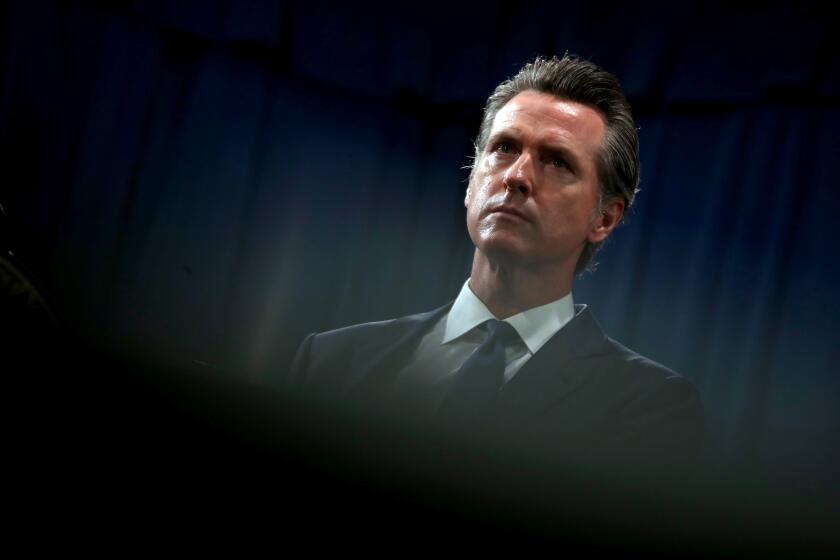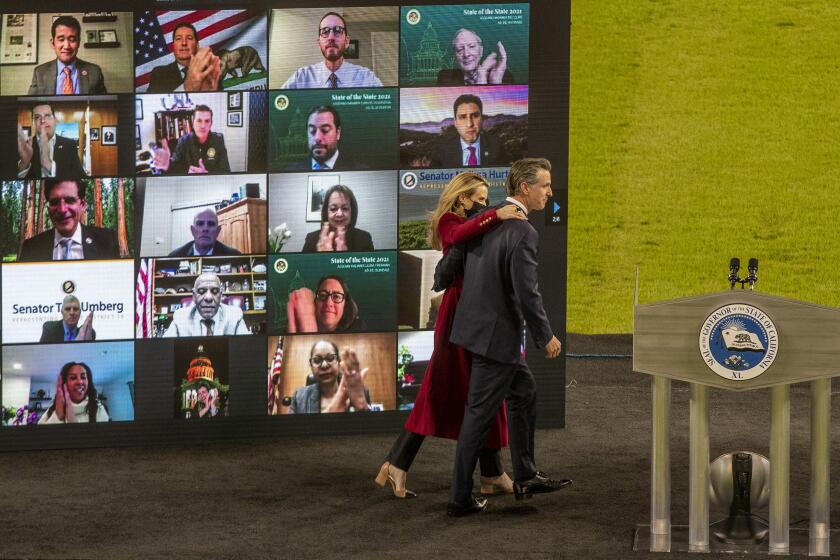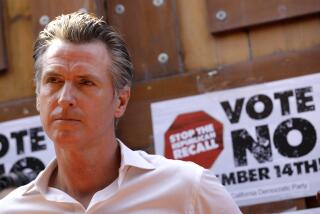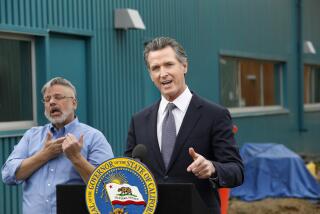Newsom recall election set for Sept. 14

SACRAMENTO â Lt. Gov. Eleni Kounalakis on Thursday set Sept. 14 as the date for the recall election targeting California Gov. Gavin Newsom, leaving it up to voters to decide whether to oust a sitting governor for just the second time in the stateâs history.
The tight election timetable gives prospective candidates just over two weeks to decide whether to jump into an expected frenzied race to replace Newsom, though a cadre of notable Republicans launched unofficial campaigns months ago with promises of loosening the Democratsâ ironclad grip on Californiaâs state government.
âNow that Newsom actually has to campaign, Iâm wondering if heâs up to the task,â said Anne Hyde Dunsmore, campaign manager for Rescue California, one of the main recall proponents. âWe havenât had to do much because he seems to be doing something every day that helps us.â
Newsom and his supporters have dismissed the recall effort as a long-shot ploy by the Republican Party to force its unpopular conservative agenda on Californians who support the governorâs policies, including his response to the COVID-19 pandemic, protecting the environment and advocating for gun control measures. The Democratic governor has characterized recall campaign leaders as anti-immigrant supporters of former President Trump who include QAnon conspiracy theorists and fringe members of the right wing.
Juan Rodriguez, the leader of Newsomâs anti-recall campaign, said California voters have an opportunity to âreject this Republican power grab.â
âThis Republican recall is a naked attempt by Trump Republicans to grab control in California â powered by the same Republicans who refused to accept the results of the presidential election and are now pushing voter suppression laws across the country,â Rodriguez said in a statement.
Still, one the greatest threats to Newsomâs political survival would be a challenge from the left. Thus far, no prominent California Democrats have publicly entertained entering the race, and most have pledged to stay out of it.
But candidates have a limited window to mull over the idea â the final day to file paperwork to run is July 16. The opportunity to lead the largest state in the union may prove too enticing to ignore, even for someone outside the realm of politics.
The attempted recall of Gov. Gavin Newsom will go before voters on Sept. 14. Here are the details.
In 2003, Californians stung by rolling power outages, budget cuts and a car tax hike voted to recall Democratic Gov. Gray Davis from office and elected Hollywood action star Arnold Schwarzenegger, the last Republican to serve as the stateâs chief executive. Davis became the first and only California governor to be recalled from office.
Kounalakisâ announcement came just after Secretary of State Shirley Weber certified the gubernatorial recall, a campaign that collected more than 1.7 million petition signatures from California voters who supported removing Newsom from office. Under the state Constitution, Kounalakis was required to schedule an election to take place 60 to 80 days after Weberâs certification.
âAlthough the window of time from which I could select a date was narrow, I believe we have chosen a fair and reasonable date for this election to take place,â Kounalakis said in a statement Thursday. âIt has always been my intention to choose an election date that gives election officials and the public ample time to ensure a smooth election with broad participation.â
The election will play out quickly in political terms: Start to finish, it will last less than three months.
Weberâs certification was considered a foregone conclusion for months and came just days after the state Legislature voted to revise the election rules dictating how the recall campaign will unfold â a move Republicans argued was to Newsomâs political advantage.
âIt is not hyperbole to say this is qualitatively the same thing that happens in corrupt sham democracies the world over,â Assemblyman Kevin Kiley (R-Rocklin), a strong supporter of the recall effort, said during the debate over the bill. âThose in power use their power to make sure they donât lose their power.â
The change, which Newsom quickly signed into law, effectively eliminated the required 30-day review of the recallâs estimated costs by the Legislature, accelerating the timeline for the election.
Some Newsom supporters advocated for holding the election as soon as possible because recent opinion polls showed Newsom had favorable job approval ratings, a rise driven in large part by Californiaâs emergence from the COVID-19 pandemic and an economy on the upswing.
On Thursday, the state Department of Finance released an updated estimate of the cost of the special election: $276 million, with the vast majority of that falling on county election agencies that must shoulder the cost of printing ballots, setting up voting sites and processing votes. The state already has set aside $250.2 million to fund the recall election.
Regardless of the odds, the recall election is expected to attract a considerable amount of money.
As the target of the recall, Newsom is allowed to raise and spend an unlimited amount to fend off his ouster. The governorâs anti-recall committee already has collected more than $16.7 million â and that was before the recall was officially certified. Newsom also has more than $20 million socked away for his 2022 reelection campaign, though itâs uncertain if heâll use any of that money, or need to, to fight the recall.
The Democratic and Republican parties have also poured money into the campaign, with more expected in the coming days.
Candidates hoping to succeed Newsom are likely to spend millions. Republican businessman John Cox of Rancho Santa Fe, whom Newsom beat handily in the 2018 governorâs race, already has tapped into $7 million of his own money for the contest.
Reality television star and retired Olympic gold medalist Caitlyn Jenner has raised more than $330,000, a modest haul. But Jenner has benefited greatly from a crush of national media attention since announcing her candidacy, despite a May poll showing she has anemic support among California voters.
That poll found that leading the Republicans in the race were former San Diego Mayor Kevin Faulconer and Cox, followed by former Northern California Rep. Doug Ose.
âThis movement is powered by Californians from every community â Democrats, Republicans and independents,â Faulconer said. âChange is coming for California and retirement is coming for Gavin Newsom.â
Voters will decide whether Newsom is recalled and, if so, who should replace him. Newsom is barred from being listed among the candidates who can be considered if the recall passes.
A Republican-led drive to remove Gov. Gavin Newsom from office has collected enough voter signatures to qualify for the ballot.
Two and a half years ago, Newsom won the governorâs office by the largest electoral margin in modern history, capping the Democratâs steady rise to the apex of California politics that began in 1996, when San Francisco Mayor Willie Brown appointed him to the cityâs Parking and Traffic Commission. After being elected mayor of San Francisco in 2003, Newsom quickly rose to national prominence with his push to legalize same-sex marriage in 2004 and later served two terms as Californiaâs lieutenant governor.
The recall campaign was fueled in large part by Californiaâs conservative minority, which has fought Newsomâs progressive policies. The recall petition accused Newsom of creating Californiaâs high taxes and homelessness crisis, and it criticized him for protecting immigrants who enter the country illegally and for halting executions.
But the governorâs policies to combat COVID-19 were what really brought the recall to life, fueled by voter discontent over government-mandated restrictions to stem the spread of the coronavirus â actions that devastated businesses, put millions out of work and forced schoolchildren into distance learning programs.
Newsomâs public image took a major hit in November, when he attended a lobbyistâs birthday party at the upscale French Laundry restaurant in Napa Valley after pleading with Californians to stay home and avoid multifamily gatherings.
The current recall effort is the sixth launched against Newsom since he took office in January 2019 and, much like the others, was initially sluggish.
However, a Sacramento County Superior Court judge in November granted recall proponents an additional five months to gather and submit 1.49 million petition signatures from California voters, the number required by state law to qualify the recall for the ballot. The judge did so because the stateâs COVID-19 shutdowns and restrictions had limited the recall campaignâs ability to circulate petitions.
Neither the governor nor the secretary of state decided to appeal that ruling, a decision that some Democrats believe was a misstep.
On Monday, another potential mistake surfaced: Newsom filed a lawsuit Monday against the secretary of state, asking the court to require Weber to print Newsomâs party preference â Democrat â on the recall ballots.
Under state law, Newsom had an opportunity to request that his party designation appear when he submitted his official response to the recall campaign. But he failed to do so due to an âinadvertent but good-faith mistake made on the part of his elections attorney.â
Times staff writer John Myers contributed to this report.
More to Read
Sign up for Essential California
The most important California stories and recommendations in your inbox every morning.
You may occasionally receive promotional content from the Los Angeles Times.









![[20060326 (LA/A20) -- STATING THE CASE: Marchers organized by unions, religious organizations and immigrants rights groups carry signs and chant in downtown L.A. "People are really upset that all the work they do, everything that they give to this nation, is ignored," said Angelica Salas of the Coalition of Humane Immigrant Rights. -- PHOTOGRAPHER: Photographs by Gina Ferazzi The Los Angeles Times] *** [Ferazzi, Gina -- - 109170.ME.0325.rights.12.GMF- Gina Ferazzi/Los Angeles Times - Thousands of protesters march to city hall in downtown Los Angeles Saturday, March 25, 2006. They are protesting against House-passed HR 4437, an anti-immigration bill that opponents say will criminalize millions of immigrant families and anyone who comes into contact with them.]](https://ca-times.brightspotcdn.com/dims4/default/34f403d/2147483647/strip/true/crop/1983x1322+109+0/resize/840x560!/quality/75/?url=https%3A%2F%2Fcalifornia-times-brightspot.s3.amazonaws.com%2Fzbk%2Fdamlat_images%2FLA%2FLA_PHOTO_ARCHIVE%2FSDOCS%2854%29%2Fkx3lslnc.JPG)



